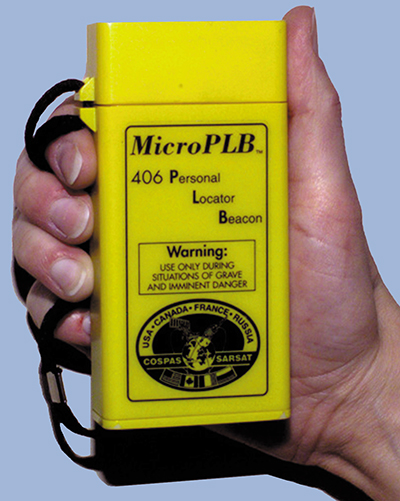Personal Beacon
Hikers, mountain climbers, and other adventure-seekers can now set out on their travels with an innovative personal locator beacon (PLB). NASA's Glenn Research Center and Goddard Space Flight Center, along with other government agencies, provided Small Business Innovation Research (SBIR) funding for the development of a miniature PLB called the MicroPLB. This commercial product is the brainchild of Microwave Monolithic, Inc. (MMInc.), of Simi Valley, California.
The MicroPLB is a state-of-the-art search and rescue satellite-aided tracking (SARSAT) transmitter that, when activated, emits a 406 MHz distress signal to a constellation of internationally operated satellites. A stranded person's identity and location anywhere on Earth is automatically deciphered and forwarded to central monitoring stations around the world. In the U.S., the National Oceanic and Atmospheric Administration (NOAA) operates the mission central center. The monitoring stations notify appropriate rescue organizations, guiding rescue personnel directly to the emergency location. The MicroPLB can be a life-saver for individuals engaged in activities such as hiking, hunting, mountain climbing, boating, and cross country skiing, where even a simple accident can escalate into a dangerous, or even life-threatening, situation. In such circumstances, timely assistance is critical.
Using the external Global Positioning System (GPS) receiver location data, the MicroPLB has been proven accurate to within just a few meters. It is a fully operational, all-weather SARSAT system that works worldwide, 24 hours a day. The system has already assisted in the rescue of over 11,000 people around the globe, including over 4,000 in the U.S. It is operated, funded, and maintained by an international consortium that assesses no fees from users.
Until recently, the primary application of the SARSAT emergency notification system has been restricted to specialized SARSAT beacons on seafaring vessels. Unlike other SARSAT beacons, the MicroPLB is a pocket-sized unit about the size of a king-sized cigarette pack. Because of its advanced, NASA-derived transmitter technology, it is also the only PLB to use a safe battery approved by the U.S. Department of Transportation for carriage via all commercial transportation, including commercial passenger aircraft. It is dangerous, and illegal in most countries, to carry most other PLBs on commercial aircraft. The batteries of many other PLB devices have demonstrated enough volatility to explode with power almost equivalent to a stick of dynamite. For this reason, many people consider it unwise to personally carry such PLBs, even though they could possibly save lives.
According to the company, the MicroPLB is safe, easy to carry, and can go wherever the user goes. In the unfortunate event that rescue is needed, it is easily activated, offering a revolutionary way of helping people stranded in times of need. The user simply uses the device's serial interface to download navigation data from a global positioning satellite receiver. Once the download process is complete, the MicroPLB will function as a self-locating beacon.
MMInc. was founded in 1982 to supply custom microwave components and subsystems to its mostly government and industry customers. With the addition of its MicroPLB product, MMInc. is now bringing its expertise to individual consumers by offering safer travel to remote places.

Microwave Monolithic, Inc.'s MicroPLB is a state-of-the-art search and rescue satellite-aided tracking (SARSAT) transmitter.













